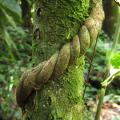
DMT-Nexus member
Posts: 1111 Joined: 18-Feb-2017 Last visit: 12-Jul-2024
|
Jozeh wrote:Maybe a test for the brave could be a cold water lemon tek to dephosphorylate aeruginascin to 4-ho-tmt. A la psilocybin to psilocin. Isn't that what happens in the body following ingestion anyway, and what is being hypothesized to be causing WLP (rather than aeruginascin directly)?
|
|
|
|
|

DMT-Nexus member
Posts: 86 Joined: 14-Oct-2017 Last visit: 24-Aug-2023
|
Jagube wrote:Jozeh wrote:Maybe a test for the brave could be a cold water lemon tek to dephosphorylate aeruginascin to 4-ho-tmt. A la psilocybin to psilocin. Isn't that what happens in the body following ingestion anyway, and what is being hypothesized to be causing WLP (rather than aeruginascin directly)? Certainly is, was drawing attention to the metabolite. It can also be seen that 4-HO-TMT isn't interested in 5ht3 receptors. Regarding the bufotenidine paralysis being caused by its strong affinity for 5ht3 and suggesting aeruginascin also. I can't find much regarding aeruginascins affinity for 5ht3 receptors. If it has a high affinity could it be some aeruginascin isnt being dephosphorylated in vivo before hitting the 5ht3 receptors and inducing WLP? Good read here: https://www.dmt-nexus.me...aspx?g=posts&t=94787 regarding 5ht3 receptor being the culprit. so a 3 stage test. normal brew suspected to induce WLP. normal brew with Juiced ginger to block the 5ht3 and avoid WLP based on 5ht3 hypothesis. a cold lemon tek to dephosphorylate aeruginascin to 4-HO-TMT, which we know doesn't have an affinity for 5ht3, assume to avoid WLP based on 5ht3 hypothesis.
|
|
|

DMT-Nexus member

Posts: 3090 Joined: 09-Jul-2016 Last visit: 03-Feb-2024
|
So now we have a suspect, is there any substance that can block these effects?
Maybe with some of the woodlovers, it would always be wise to at least always have something at hand that could stop these effects.
|
|
|

❤️🔥
 
Posts: 3648 Joined: 11-Mar-2017 Last visit: 15-Dec-2025 Location: 🌎
|
I've been going through other forums and so far all reports are from eating (dry and raw), teas, or lemon Tek. So far I cannot find any woodlovers paralysis reports from an ethanol tincture.
|
|
|

DMT-Nexus member
Posts: 218 Joined: 14-Apr-2018 Last visit: 05-May-2024
|
Nice to bring back this topic. I would be interested in helping to research this stuff. I got it once, with old cyanescens, and stopped all experimentation after because the effects are really, really unpleasant. But it would be better to know how to prevent this, because woodlovers are so easily available psilocin-fabricants. Arthur Dee was one of the greatest alchemists of all time, not likely to his dad, I forgot his name, this small James Bond sorcerer working for the queen of a... Hail Arthur!
|
|
|

DMT-Nexus member
Posts: 1111 Joined: 18-Feb-2017 Last visit: 12-Jul-2024
|
Loveall wrote:I don't know. I would guess aeruginascin would be soluble in methanol. The quote below seems to imply otherwise? From https://psychedelicrevie...m/compound/aeruginascin/Quote:In 2020, Sherwood et al. published a synthetic method to produce aeruginascin.5 They made aeruginascin by quaternization of psilocybin “using excess methyl iodide in methanol treated with aqueous ammonium hydroxide.” The aeruginascin was collected by filtration and washing with methanol.
|
|
|

❤️🔥
 
Posts: 3648 Joined: 11-Mar-2017 Last visit: 15-Dec-2025 Location: 🌎
|
Jagube wrote:Loveall wrote:I don't know. I would guess aeruginascin would be soluble in methanol. The quote below seems to imply otherwise? From https://psychedelicrevie...m/compound/aeruginascin/Quote:In 2020, Sherwood et al. published a synthetic method to produce aeruginascin.5 They made aeruginascin by quaternization of psilocybin “using excess methyl iodide in methanol treated with aqueous ammonium hydroxide.” The aeruginascin was collected by filtration and washing with methanol. Possibly but not certain. In synthesis only 'less soluble' than impurities can be good enough because if the ratio to product to impurities is high before the wash. See attached for an old paper from Gartz. I think they used the 24h ground room temp methanol extraction to get the indoles (including aeruginascin I believe). This implies some solubility in methanol.
|
|
|
DMT-Nexus member
Posts: 117 Joined: 26-Jan-2020 Last visit: 29-Jan-2025
|
I get wood lovers paralysis. Below 2 grams there is usually none. Over 2.5 grams I loose ability to focus my eyes well after the peak. 4 grams or more the inability to focus is very pronounced. Can not focus my eyes at all. Quite strange. Also weakness in the quad muscles. It seems to become more pronounced every time; which seems to implicate upregulation of the receptors responsible.
In terms of extracting away from the compound; I would place bets that, if the compound is aeruginascin the Casale A/B extraction would not extract it because a weak acid should not remove the positive charge of a trimethyl amine. I could be completely mistaken. People here seem not to like the Casale procedure but reports indicate ascorbate works well to stabilize the extract.
Otherwise extracting to methanol, drying, and then recrystallizing seem like the best option; although would have no idea whether or not this would exclude aeruginascin. I would think aeruginascin would be soluble in methanol; because small charged compounds seem to be universally soluble in water and ethanol/methanol.
|
|
|

❤️🔥
 
Posts: 3648 Joined: 11-Mar-2017 Last visit: 15-Dec-2025 Location: 🌎
|
Scylla wrote:I get wood lovers paralysis. Below 2 grams there is usually none. Over 2.5 grams I loose ability to focus my eyes well after the peak. 4 grams or more the inability to focus is very pronounced. Can not focus my eyes at all. Quite strange. Also weakness in the quad muscles. It seems to become more pronounced every time; which seems to implicate upregulation of the receptors responsible.
In terms of extracting away from the compound; I would place bets that, if the compound is aeruginascin the Casale A/B extraction would not extract it because a weak acid should not remove the positive charge of a trimethyl amine. I could be completely mistaken. People here seem not to like the Casale procedure but reports indicate ascorbate works well to stabilize the extract.
Otherwise extracting to methanol, drying, and then recrystallizing seem like the best option; although would have no idea whether or not this would exclude aeruginascin. I would think aeruginascin would be soluble in methanol; because small charged compounds seem to be universally soluble in water and ethanol/methanol. This is what I would do to try to decrease the aeruginascin ratio: 1) Cold water/ice extract of diced mushrooms. I've done this before when trying to get the blue juice and it was not active. However, it may efficiently extract aeruginascin. 2) Consume as usual after the cold water extract. As mentioned in the link above, the mushrooms were still very active after the cold water soak. Another option I would try is to make a mushroom tea, cool it down quickly (with ice), add baking soda to make the solution slightly alkaline and the actives less positive, and quickly filter with a cation resin (standard stuff used in water filtration), acidify immediately with lemon juice to minimize chances of oxidation and consume.
|
|
|

DMT-Nexus member
Posts: 128 Joined: 03-Jun-2017 Last visit: 14-Jun-2022 Location: European Union
|
Loveall, downwardsfromzero I am looking for some evolutionary insight into quaternary ammonium salts. Loveall wrote:From: https://en.m.wikipedia.o...romuscular-blocking_drugQuote:Quaternary ammonium muscle relaxants are quaternary ammonium salts used as drugs for muscle relaxation, most commonly in anesthesia. It is necessary to prevent spontaneous movement of muscle during surgical operations. Muscle relaxants inhibit neuron transmission to muscle by blocking the nicotinic acetylcholine receptor. downwardsfromzero wrote:
Incidentally, several quaternary ammonium compounds such as candicine have been found in cacti and candicine has been shown to cause paralysis in frogs. So, bufotenidine = quaternary arylethylammonium compound = paralysis; candicine = quaternary arylethylammonium compound = paralysis; aeruginascin = quaternary arylethylammonium compound = found in mushrooms known to cause paralysis???
Is it possible that the evolution of human digestion away from consuming quaternary ammonium compounds is the reason for the interaction? Is it frequently occuring in plant life or not? Are there any other examples of quaternary ammonium salt containing plants that you have come across? What about sources of the gene coding for this? Is this a radical in a complex process, or is it an easy to identify gene involved with simple processes? Another query if gene info is found: can you trace back a likely genetic mutation that allowed for this substituted amine version? Are there tertiary ammonium cations alternatives?
|
|
|

Boundary condition

Posts: 8617 Joined: 30-Aug-2008 Last visit: 29-Nov-2025 Location: square root of minus one
|
To add a data point, about 2 hours in to 430mg dose of Ps. ovoideocystidiata there was an episode of noticeable weakness and incoordination in the legs. (This was not autosuggestion - at the time it was thought to be related to a pre-existing spinal injury.) Muladharma, the quaternary ammonium compounds block various kinds of acetylcholine receptors because the shape and dimensions of their charge distribution allows them to fit into the receptor site. Further plant-based quaternary ammonium compounds with a neuromuscular blocking action include tubocurarines and calebassines, classic components of arrow poisons. Their molecular structures are considerably more complex than the simple methylated arylethylamines mentioned above. Tertiary amine cations would simply be something like protonated psilocybin. Other than that, I'm struggling to grasp what assumptions your question regarding "the evolution of human digestion away from consuming quaternary ammonium compounds" is based on. Methylation is an incredibly simple and universal biotransformation. “There is a way of manipulating matter and energy so as to produce what modern scientists call 'a field of force'. The field acts on the observer and puts him in a privileged position vis-à-vis the universe. From this position he has access to the realities which are ordinarily hidden from us by time and space, matter and energy. This is what we call the Great Work." ― Jacques Bergier, quoting Fulcanelli
|